Seven Questions Over Breakfast with Debbie Ridpath Ohi
 January 19th, 2016 by jules
January 19th, 2016 by jules
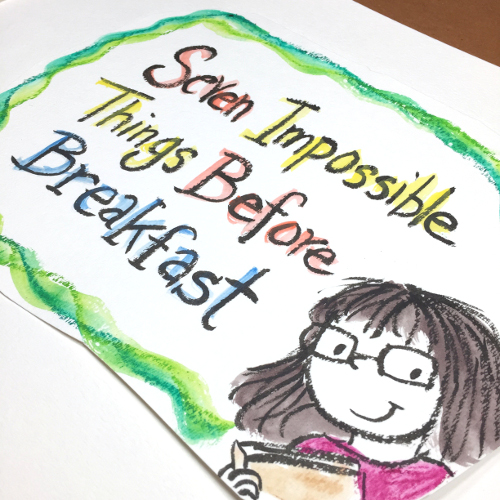
If I had to create at, say, knife-point a list of the Funniest Picture Books of the Last Decade (that sounds violent, but I’m not a fan myself of creating such superlatives-lists), I’d put Michael Ian Black’s I’m Bored, illustrated by my guest Debbie Ridpath Ohi (her illustrated self-portrait is above), on that list. What can I say? I’m a fan of the potato.
Know what else I am? Slow. Or busy. Or both. When Debbie released a new picture book last year, one she’d both written and illustrated, she sent me these interview responses, and I’m just now getting around to posting the interview. I thank her for her patience — and also this image of us getting ready for breakfast:
It looks like we’re having tea and toast, though I’ll have to make some coffee too. Also, we’ll have steelcut oatmeal with raisins, because that’s her breakfast-of-choice. “I like the texture,” Debbie tells me, “especially if they’re fresh-cooked and a little crunchy. I never used to like oatmeal until I read Angela’s Ashes.”
I really enjoyed this interview, because I learned quite a few new things about Debbie. You think you know someone—at least from their public persona—and then they up and surprise you. I like that. Also, I like the way she sees the world (her found-object art being a lovely case-in-point). Let’s get right to it, shall we?
Thanks again to Debbie for visiting. …

Jules: Are you an illustrator or author/illustrator?
(Click last two images to enlarge)
Jules: Can you list your books-to-date?
Debbie: You can find a full list at DebbieOhi.com/books, but my five most recently illustrated titles are:
- Where Are My Books?, a picture book written and illustrated by me (Simon & Schuster Books For Young Readers)
- Naked!, a picture book written by Michael Ian Black and illustrated by me (Simon & Schuster Books For Young Readers)
- I’m Bored, a picture book written by Michael Ian Black and illustrated by me (Simon & Schuster Books For Young Readers)
- Freckle Juice, a chapter book written by Judy Blume and illustrated by me (reissued by Atheneum/Simon & Schuster)
- The Pain and The Great One, a chapter book written by Judy Blume and illustrated by me (reissued by Atheneum/Simon & Schuster).
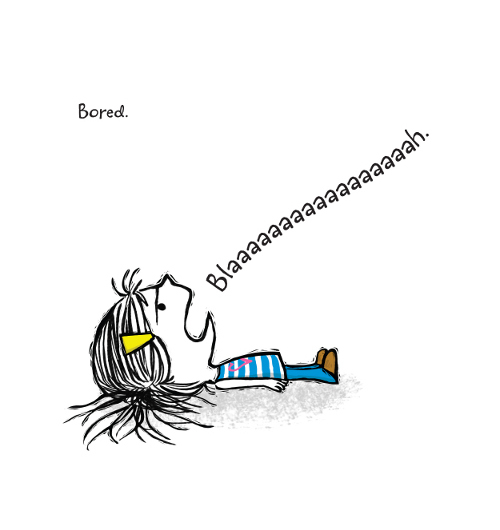
Jules: What is your usual medium?
Debbie: So hard to choose! Most of my book projects are digital, and I’m very comfortable with digital tools. For my illustrations in Sea-Monkey and Bob (written by Aaron Reynolds, however, coming out from Simon & Schuster in Spring 2017), I’m using mixed media.
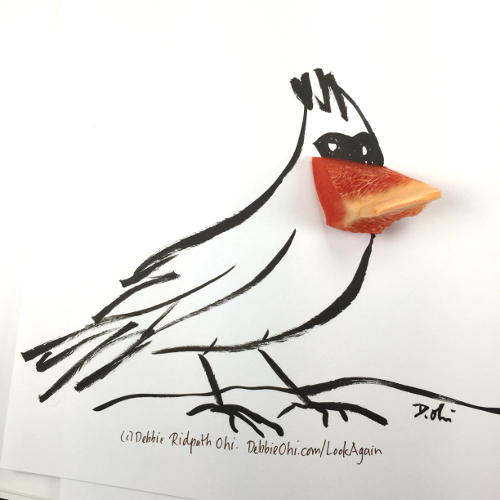


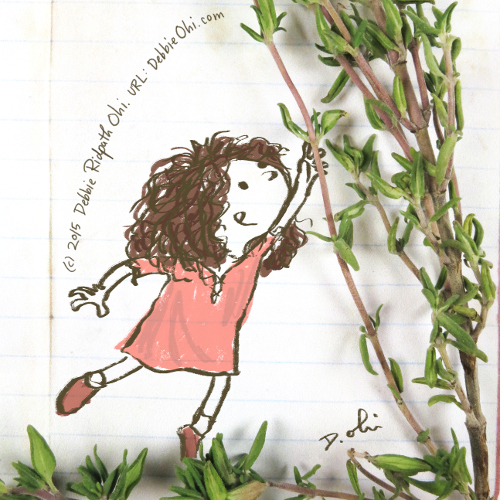
Jules: If you have illustrated for various age ranges (such as, both picture books and early reader books OR, say, picture books and chapter books), can you briefly discuss the differences, if any, in illustrating for one age group to another?
Debbie: I’ve illustrated both picture books and chapter books, but I’m not sure if I have enough experience to be able to compare the experience. The three chapter books I illustrated were reissues of Judy Blume titles from Atheneum/Simon & Schuster. Freckle Juice was one of my favorite books when I was growing up, and I was both thrilled and terrified to come up with new illustrations. The chapter book illustrations were all in black and white, with a few per chapter.
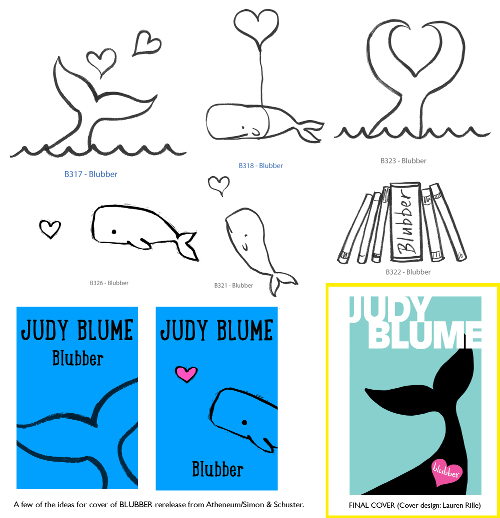
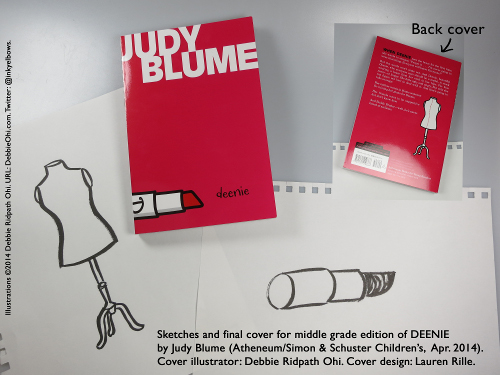
With picture books, I enjoy playing around with color and also am more aware of page turns and visual flow. I like the flexibility and additional creative potential of illustrating picture books, because you don’t necessarily want to draw exactly what’s in the text. I especially enjoy illustrating picture books where the illustrator has purposely left a lot of room for the illustrator; this was the case in both of the Michael Ian Black books I illustrated.
Jules: Where are your stompin’ grounds?
(Click each to enlarge)
Jules: Can you briefly tell me about your road to publication?
Debbie: Once upon a time, I was a systems programmer/analyst in Toronto. I opted for CompSci in university, despite my love of the arts, because everyone knows you can’t make a living making books. Programming was fun and creative in school but not so fun and creative in the real world, I found — or at least not where I ended up working. Encouraged by my husband (then my boyfriend), I finally quit. While I pursued my freelance writing career, I also earned money working in a children’s bookstore, working at the Toronto Public Library, and teaching piano and flute.
My agent and I sent out my middle-grade novels and, while none sold, the rejections got more encouraging; I could tell I was getting close. Meanwhile, I always loved to draw for the fun of it and enjoyed sharing my doodles and comics online.
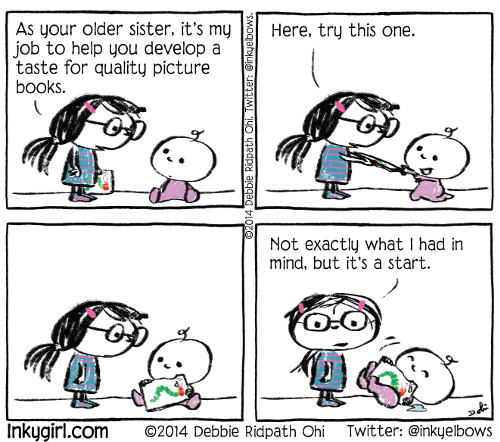
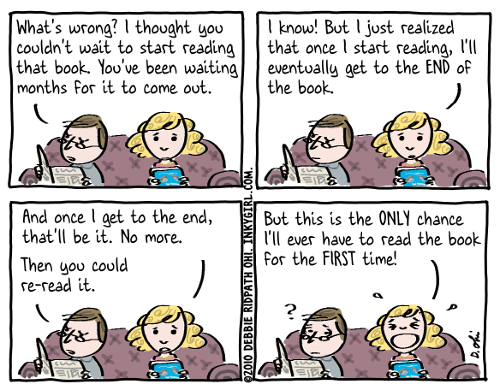
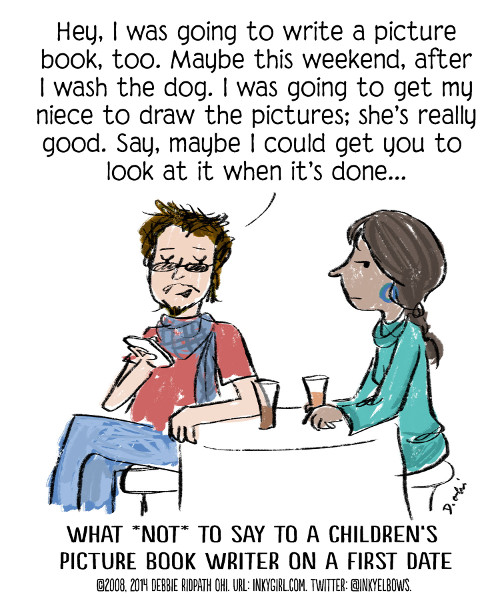
When I started attending SCBWI conventions, my illustrator friend Beckett Gladney helped me put together my very first portfolio for the 2010 SCBWI Summer Conference in L.A. My sister encouraged me, too! I ended up winning a Mentorship Program Award, as well as an Honor Award in overall Showcase. One of the judges for the latter award was Justin Chanda, an editor and publisher at Simon & Schuster Children’s. Justin asked me if I’d be interested in illustrating Michael Ian Black newest picture book. Two years later, I’m Bored was published!
(Click to enlarge)
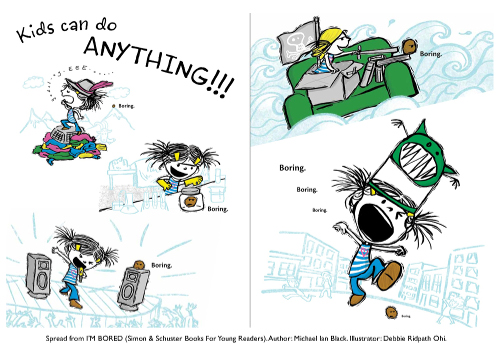
(Click to enlarge)
Jules: Can you please point readers to your web site and/or blog?
Debbie: DebbieOhi.com – about me and my projects; Inkygirl.com – my blog about reading, writing and illustrating children’s books.
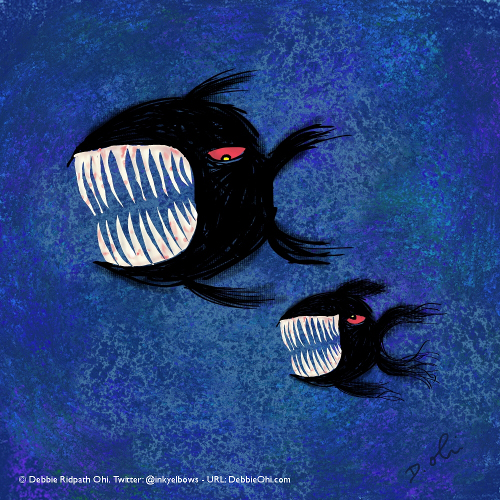

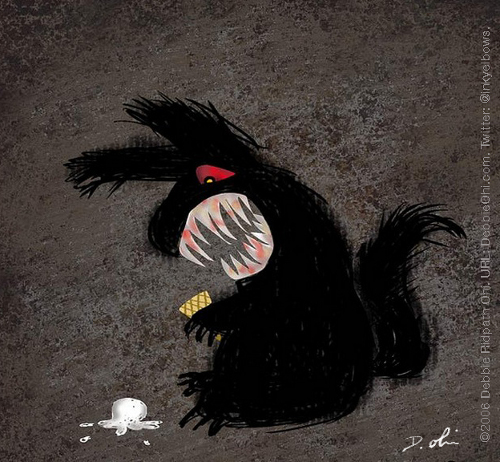
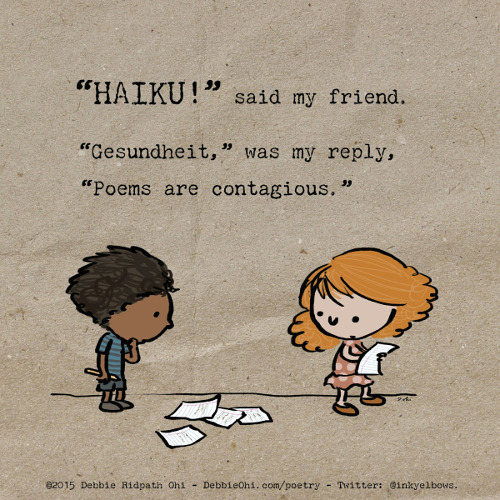
Jules: If you do school visits, tell me what they’re like.
Debbie: Because of geography and not being able to drive, I don’t do a lot of in-person school visits, unless I’m on a book tour. I do a lot more virtual visits, though, via Skype and Google Hangouts. Depending on what book the students have read and what format the school prefers, I usually do (1) a reading, (2) talk about my process and show some early sketches, (3) do an interactive drawing demo, and (4) do a Q&A.

I used to be super nervous about the idea of talking in front of kids, but when I started doing it, I was surprised to find out how much I enjoyed connecting with young readers.
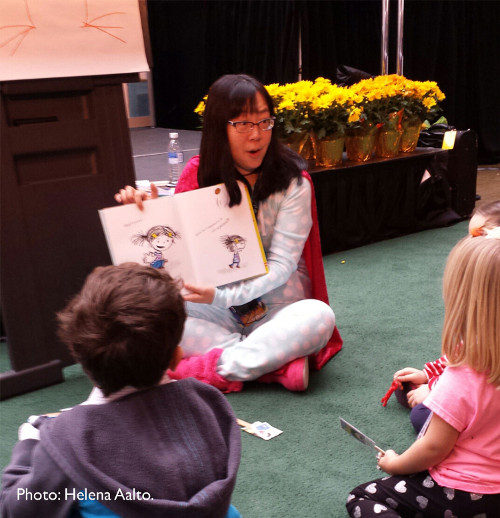
Jules: Any new titles/projects you might be working on now that you can tell me about?
Debbie: I’m finishing up the illustrations for several picture book projects this year, including the second Ruby Rose picture book (author: Rob Sanders, HarperCollins Children’s), the second Mitzi Tulane picture book (author: Lauren McLaughlin, Random House Children’s), and Sea-Monkey and Bob (author: Aaron Reynolds, Simon & Schuster Children’s), and will be starting work on my second solo picture book for Simon & Schuster very soon. I also have several other projects on the go, including a middle-grade novel which I have moved off the back burner onto my “stop procrastinating and FINISH THIS BOOK” list.
In 2016, I have two picture books coming out: Ruby Rose, Off to School She Goes, written by Rob Sanders and illustrated by me (HarperCollins Children’s, June/2016), and Mitzi Tulane, Preschool Detective: What’s That Smell?, written by Lauren McLaughlin and illustrated by me (Random House Children’s, July/2016).
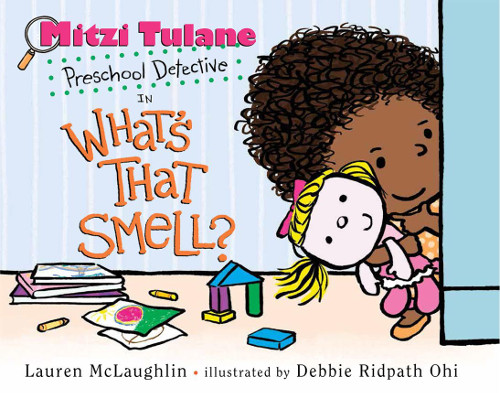

 Okay, we’ve got our coffee, and it’s time to get a bit more detailed with seven questions over breakfast. I thank Debbie again for visiting 7-Imp.
Okay, we’ve got our coffee, and it’s time to get a bit more detailed with seven questions over breakfast. I thank Debbie again for visiting 7-Imp.
1. Jules: What exactly is your process when you are illustrating a book? You can start wherever you’d like when answering: getting initial ideas, starting to illustrate, or even what it’s like under deadline, etc. Do you outline a great deal of the book before you illustrate or just let your muse lead you on and see where you end up?
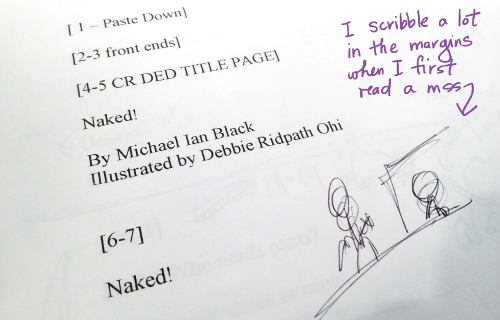
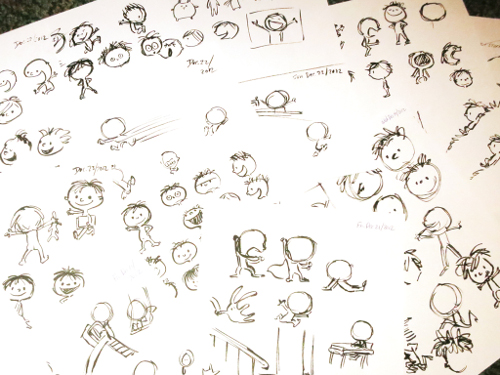
(Click each to enlarge)
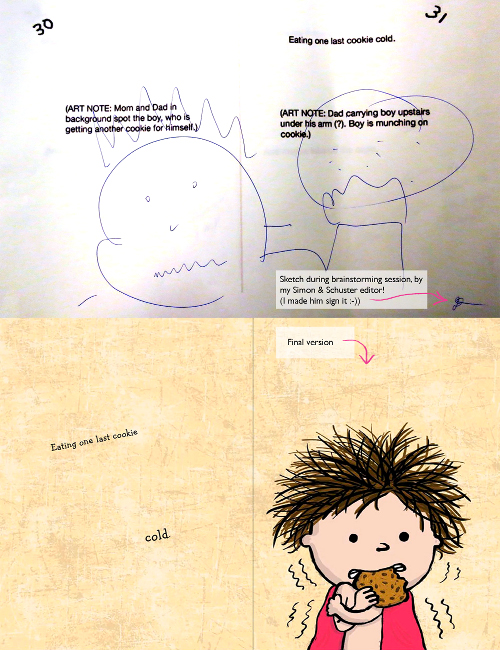
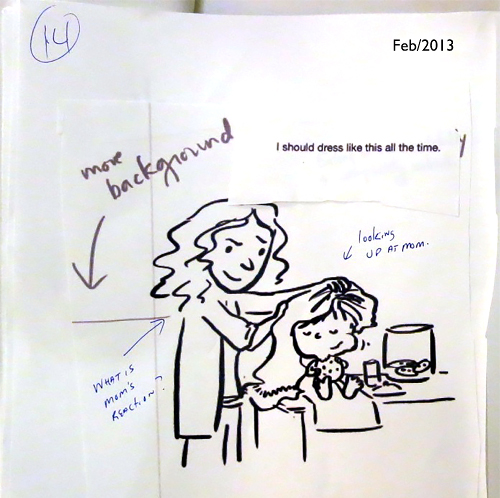
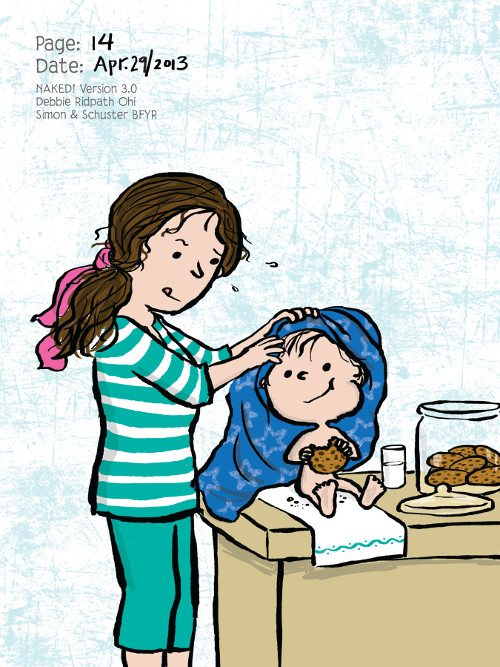
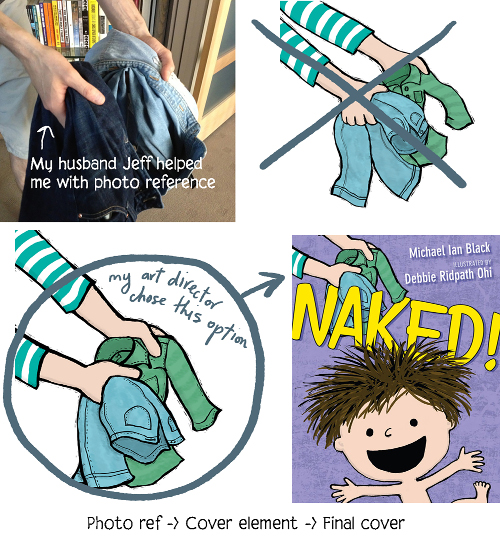
Debbie: First, I print out the manuscript and read through it a zillion times, scribbling notes and tiny sketches in the margins. Then I do a series of small thumbnail sketches on one piece of paper, so I can figure out the overall flow; I do many versions. The boxes are small, but this prevents me from getting carried away with details. When I have a version I’m happy with, then I do a bigger version of each spread (art is still very rough) and also place the text so that my art director can see how I’m envisioning the spread.
I also inevitably go through a “oh my gosh, I totally suck, what on earth am I doing” panic at least once during this early stage.

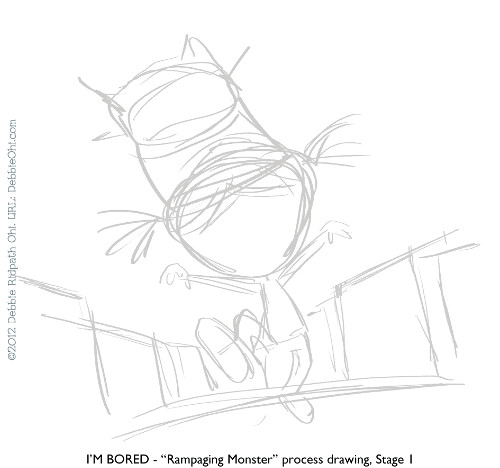
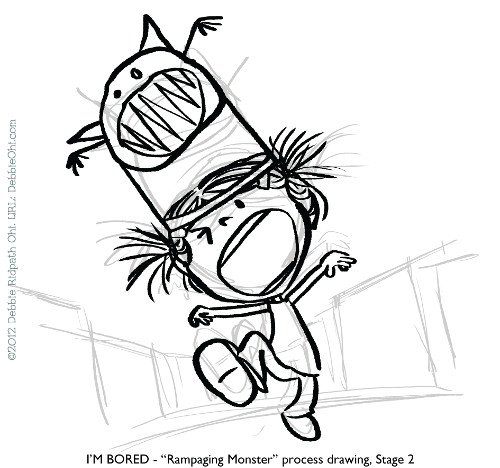
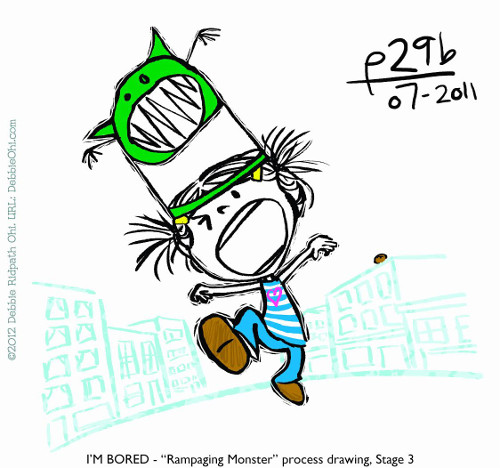

(Click each to enlarge)

Sometimes I do these larger sketches on paper and scan them into Photoshop, but I usually switch to digital sketching at this point, because it enables me to more easily tweak facial expressions and try out different options. When I’ve finished my first draft of layout sketches, I send them to my publisher. The art director and editor look them over, and then I get feedback on what’s working, what’s not working, plus suggestions for tweaks.
Occasionally, I’m asked to go straight to final art from that point, but usually there are at least a few more rounds of sketches before we’re all happy.
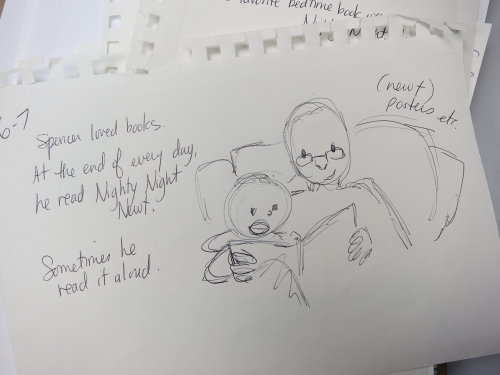
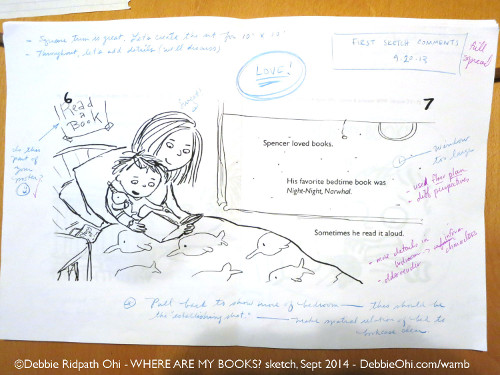
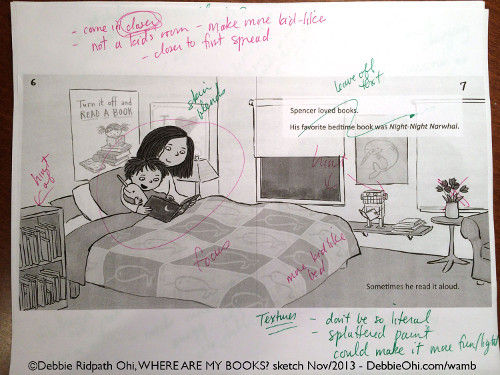

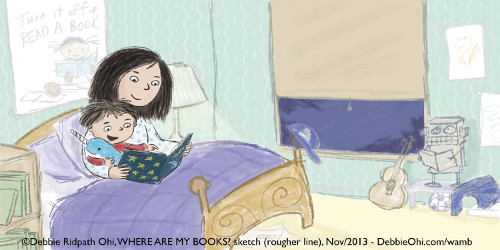
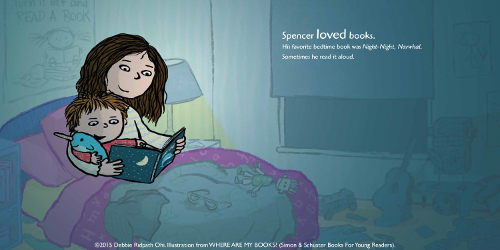
(Click each to enlarge)
Because my natural style is fairly loose, one challenge I faced early on is learning how to revise art and still keep the same energy. My method: I redraw images a lot. Many of the illustrations in Where Are My Books?, for example, were re-drawn at least 40-50 times.
For most of my books up to now, I’ve been doing final art entirely digitally. For Sea-Monkey and Bob, I’ve been experimenting with mixed media techniques. My process isn’t finalized yet, but I’ve been having a lot of fun with it.
Where Are My Books? was my first solo picture book, and I started with writing the manuscript. I worked with Justin Chanda at Simon & Schuster on revisions, and partway through the process I started working on the layout at the sketches at the same time. We went through many, many drafts. I ended up changing some of the text as I worked on the illustrations.
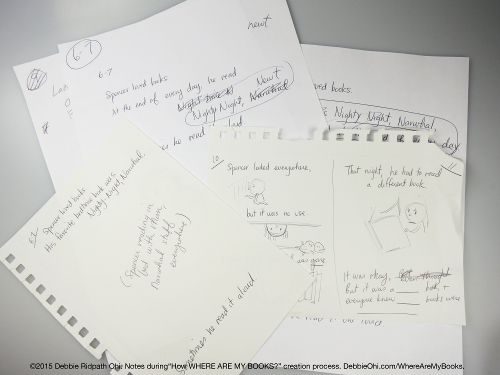

(Click each to enlarge)

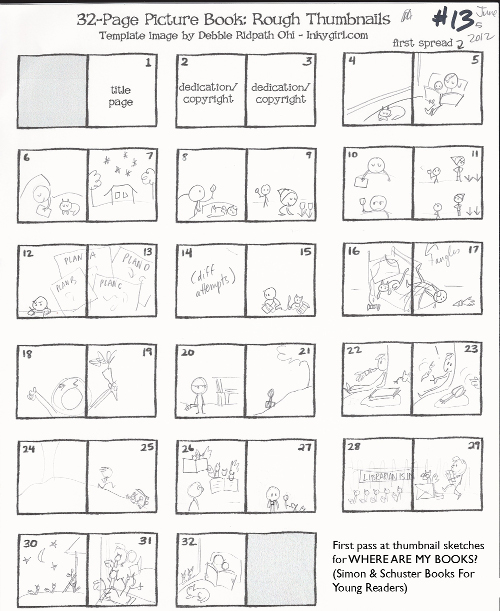
for Where Are My Books?
(Click each to enlarge)
2. Jules: Describe your studio or usual work space.
Debbie: My studio is in the basement of our house. When my husband and I first moved into the house, he asked if I wanted the extra room on the second floor as my office. It gets lots of light and has a nice view. Instead, I opted for the basement.
Why opt for underground and tiny windows instead of a light, airy room with a view? Because I found the cave-like retreat comforting and liberating. I like the idea of my own space that was clearly separate from the rest of the house, where I could leave things out and not tidy everything up right away. My husband, who is very neat and organized, knows that he is not allowed to rearrange anything in my office. I confess that I have occasionally left an item out on the floor just to torture him, because I know he is fighting the urge to pick it up and put it away for me. I am a bad, bad wife. Hopefully he won’t read this far in the interview.


People who come visit our house for the first time often comment on the tasteful and subdued color scheme and furnishings. They assume, because I am the artist, that I am responsible. The truth is that Jeff, my husband, was almost entirely responsible. If I lived alone, my house would be a chaos of color and mismatched furniture, with any empty wall space filled up with bookshelves or art. When a friend came to visit us for the first time in our new house, they were given a tour of the other floors before my office. His observation, after a few minutes of stunned silence: “Wow. I think there’s more stuff in this office than in the rest of your house combined.”
As I’m starting to experiment more with non-digital techniques, I do admit to wishing for more space. I am starting to interrogate my sister and other illustrators who work with real-life art media: “WHERE DO YOU KEEP ALL YOUR STUFF??” I am in desperate need of a Tardis.

3. Jules: As a book-lover, it interests me: What books or authors and/or illustrators influenced you as an early reader?
Debbie: Dandelion Wine by Ray Bradbury made me aware of how voice can enhance the reader experience. The Phantom Tollbooth by Norton Juster and Jules Feiffer delighted me with its wordplay; I especially loved the banquet scene, where guests literally eat their words.
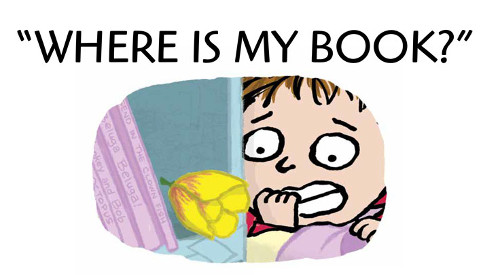
For picture books, I was drawn to stories whose text and/or art made me feel deeply sad or scared or disturbed, like Swimmy, Where The Wild Things Are, Sylvester and The Magic Pebble, and the Madeline books, but that then brought me back again. I was fascinated by all things dark, and I still like aspects of the horror genre. Ironic, I know, since my picture books so far are all very bright and cheery and not-at-all scary.
Someday, I’d like to illustrate or perhaps write and illustrate a darker picture book.
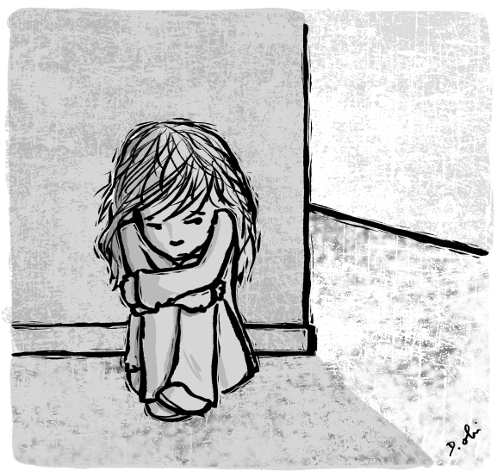
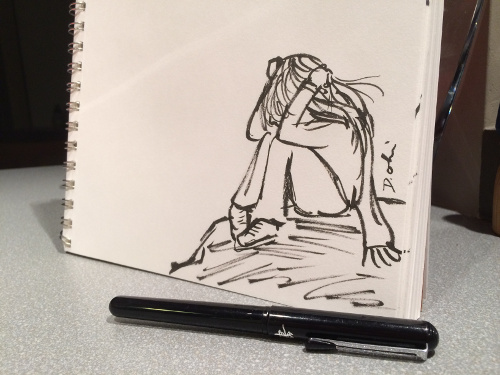
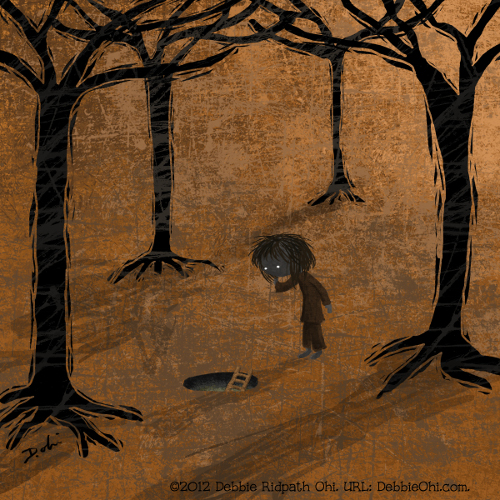
4. Jules: If you could have three (living) authors or illustrators—whom you have not yet met—over for coffee or a glass of rich, red wine, whom would you choose? (Some people cheat and list deceased authors/illustrators. I won’t tell.)
Debbie: Cece Bell, Melissa Sweet, and Sophie Blackall.
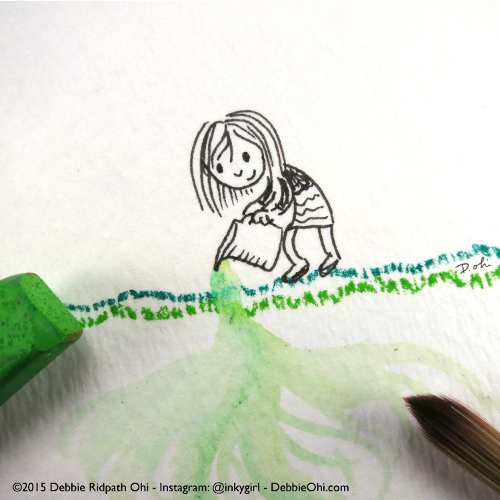
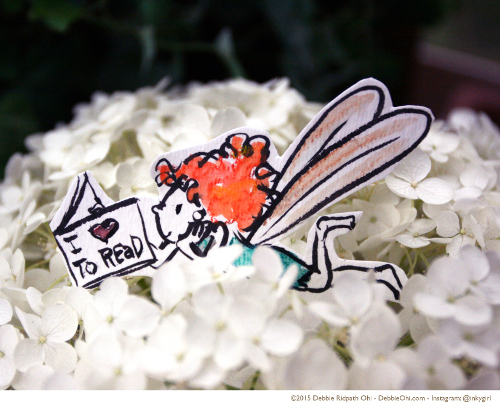
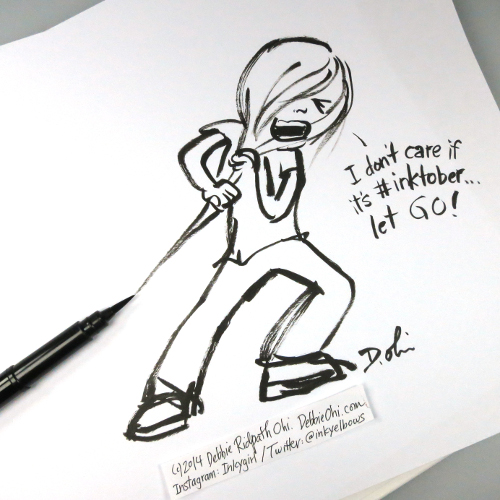
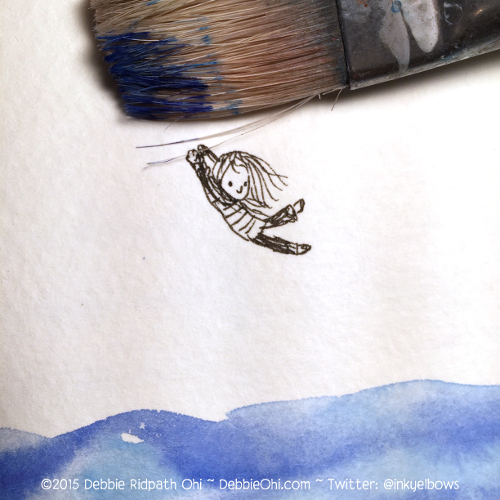
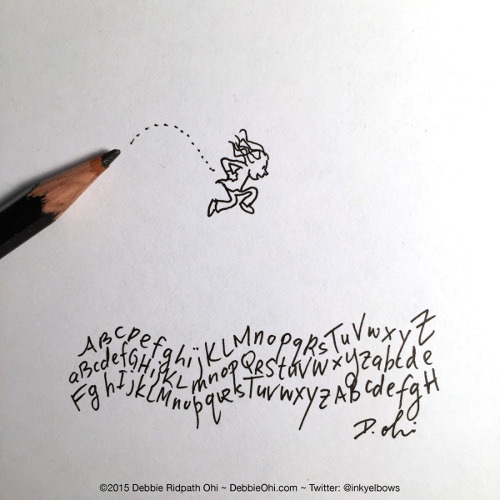
5. Jules: What is currently in rotation on your iPod or loaded in your CD player? Do you listen to music while you create books?
Debbie: When I’m writing, I can’t listen to music that has understandable lyrics. I prefer silence or atmospheric music or Italian progrock, like La Locanda delle Fate.
For illustrating, it depends on what stage. If I’m in the early creative stages, I prefer silence. Later on, I can listen to any kind of music. My favorite albums this past week on repeated play: Time by Electric Light Orchestra, Vs Evil by Ookla The Mok, Time Will Tell by Jodi Krangle and Chris Conway, and the soundtrack to Avenue Q. I also listen to a lot of audiobooks.
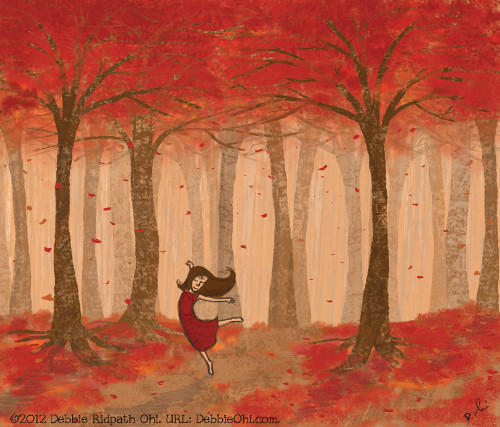
6. Jules: What’s one thing that most people don’t know about you?
Debbie: That I had a bad stammering problem when I was a child. It was so severe at one point that I couldn’t even say “hello” when answering the phone. I did whatever I could to avoid public speaking throughout school, including avoiding taking any courses in university that had a public speaking requirement.
When my books started coming out, I knew I could no longer avoid doing public speaking. I was terrified in the beginning, but it’s getting easier. I’m even discovering that I (*gasp*) enjoy it sometimes, especially when I’m talking to young readers about things I’m excited about. It helps a lot if I can incorporate a visual component, like a drawing demo or a slideshow. I still find audio-only live interviews and podcasts super-stressful, but I’m gradually getting better at it.
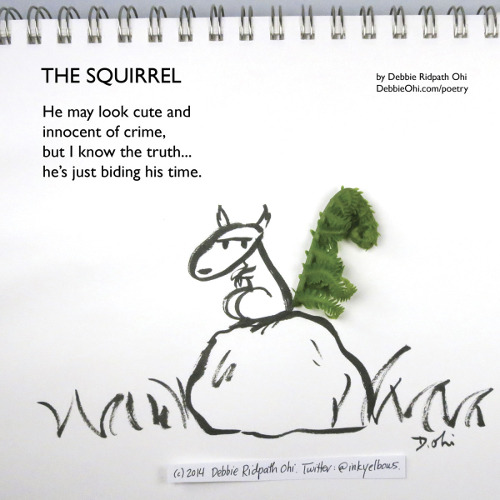

In retrospect, I am absolutely positive that my speech difficulties as a young person helped fuel my love of writing, drawing, and creating music. Despite being a lifelong introvert, I’ve always loved connecting with others and found it could be super-frustrating when my inability to properly express myself through spoken language got in the way.
Instead, I poured all that frustrated energy into my art, music, and the written word — especially art. I was aware that my style was not the most sophisticated and my art sometimes totally sucked; if you don’t believe me, check out my Waiting For Frodo webcomic. But I discovered that my readers didn’t care, as long my story and characters connected with them. This last bit was such an important lesson for me, one that I continue to remember in my professional work.


7. Jules: Is there something you wish interviewers would ask you — but never do? Feel free to ask and respond here.
Debbie: Q. What’s your go-to comfort book? Comfort movie? Comfort solo game?
My go-to comfort book is A Little Princess by Frances Hodgson Burnett. My favorite scene in that book is the first time Sara Crewe wakes up and finds her attic room transformed.
My go-to comfort movie is Titanic. No matter how stressed I am in real life, I can tell myself that hey, at least I’m not on a sinking ship in the middle of the North Atlantic Ocean.
My favorite comfort solo game is Minecraft. I originally started playing Minecraft to connect with my young nephews, but they’ve since moved on to first-person shooters — and I’m still totally hooked. I find it oddly therapeutic.

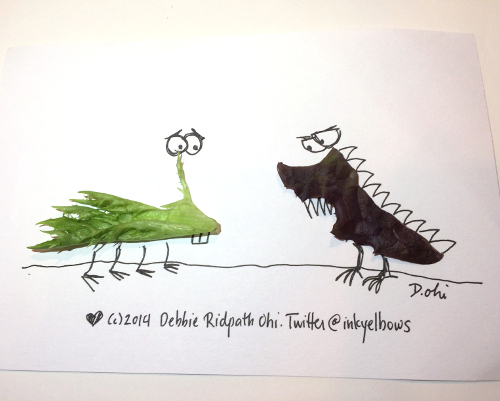
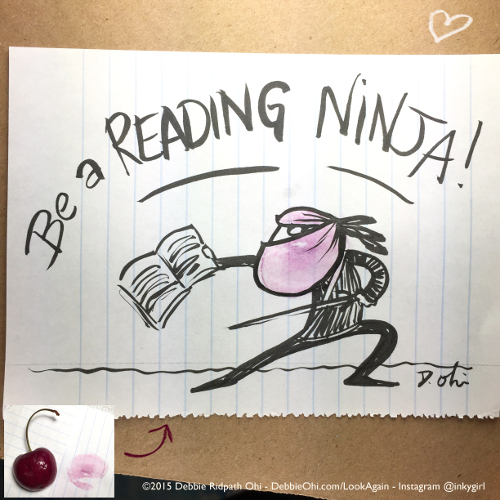
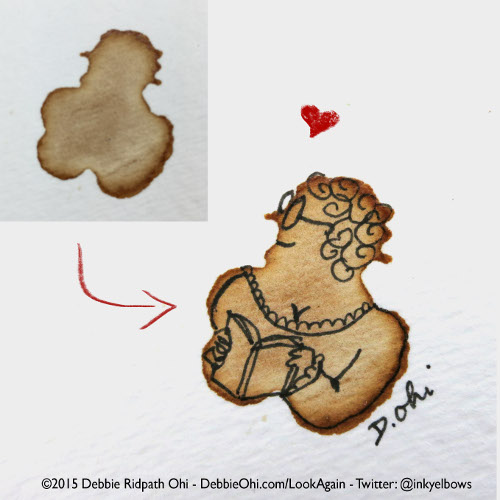


Jules: What is your favorite word?
Debbie: “Hope.” It’s a noun, a verb, a proper name, and what I look for at the end of every book.
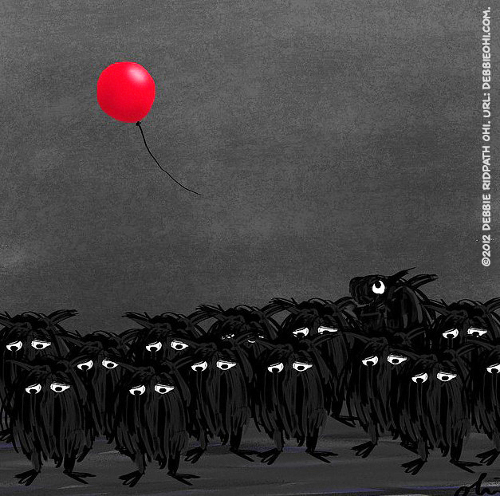
Jules: What is your least favorite word?
Debbie: “Sciuridae.”
Jules: What turns you on creatively, spiritually or emotionally?
Debbie: Being around creative, positive people who inspire me.
Jules: What turns you off?
Debbie: Passive-aggressives and unrelenting cynics.
Jules: What sound or noise do you love?
Debbie: In terms of sounds I consider beautiful, I’ve always loved the sound of the harp. I own a Celtic harp, which I play very poorly. But the latter doesn’t matter, because even if I plucked random strings, everything sounds wonderful on a tuned Celtic harp!
As for more complicated noise-love: Dial-up technology has long been outdated, but I still get a warm, fuzzy feeling of satisfaction whenever I hear the sound of a connecting modem. I keep meaning to set my ringtone to that noise. I am such a nerd.
Jules: What sound or noise do you hate?
Debbie: Anything, if it’s repeated too often and/or too loud.
Except for Celtic harp, of course.
Jules: What profession other than your own would you like to attempt?
Debbie: In another life, I would have liked to pursue screenwriting. I used to write a lot of scenes from non-existent plays and movies, which I never showed anyone. They were inevitably scary (I’m a fan of horror) or depressing.
Jules: What profession would you not like to do?
Debbie: Surgeon. If I screw up in my profession, at least I know no one’s life is on the line.
Jules: If Heaven exists, what would you like to hear God say when you arrive at the Pearly Gates?
Debbie: “Nicely done.”
All images are used by permission of Debbie Ridpath Ohi.
The spiffy and slightly sinister gentleman introducing the Pivot Questionnaire is Alfred, copyright © 2009 Matt Phelan.
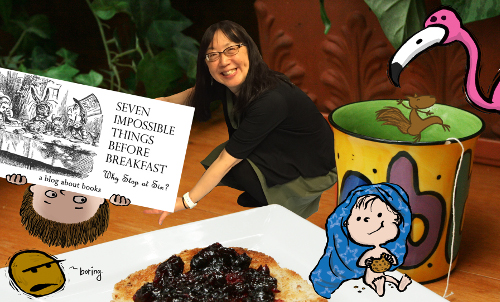

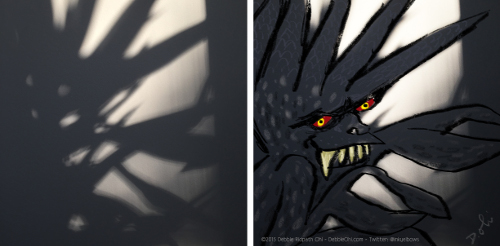


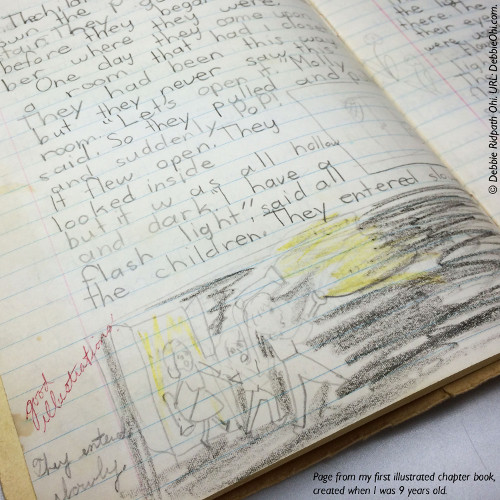
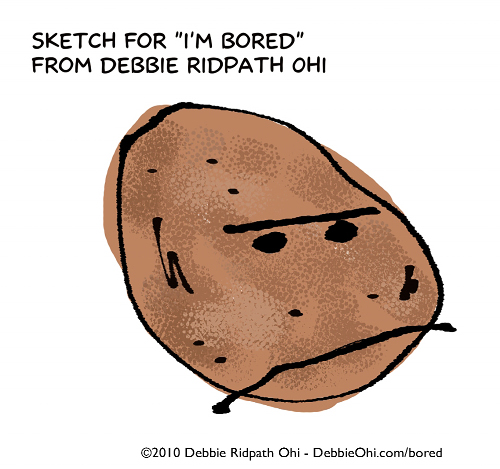
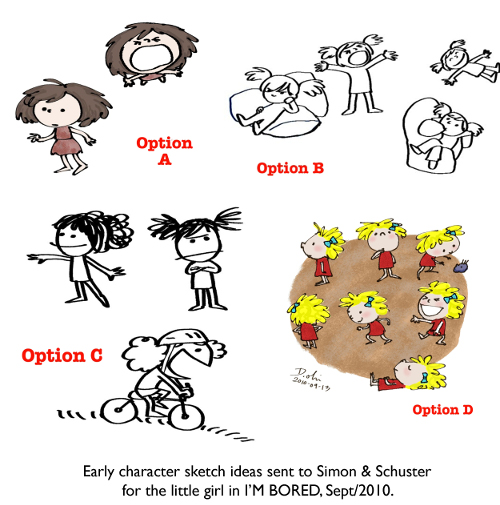
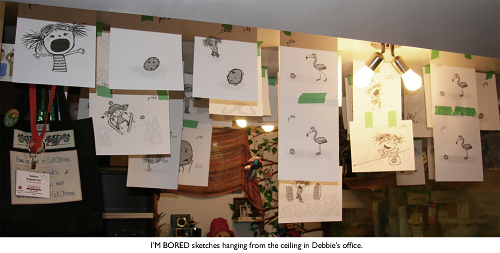

How fun it is to read about Debbie! She is a warm, wonderful, and talented lady. I’ve enjoyed watching her career take off! Thank you for the interview!
Wonderful interview! Love seeing all the art!
I’ve literally been lurking around Debbie’s websites for YEARS and it’s a joy to see things happen for her, and to see her here – two of my favorite people in one place!
Let me highly recommend virtual visits with Debbie to anyone who works somewhere such things are useful–we had one in the Fall with grade 2-3 and it was amazing, the kids are still talking about it (especially her potato costume)!
Thank you for this candid look into Debbie’s process and life as an author-illustrator! I savored every word and image. Love, love, love this blog. xoxo
These are great, so funny and beautiful at the same time. Thanks for sharing screen shot of track changes–always comforting to see that other people’s screens look that way!
The drawing or cartoon of the little old lady reading a book is so funny. Just like a group of old ladies at a brunch talking about this or that and a bit of gossip. Illness and church talk??? My dear grandmother and her friends were always having get to gathers??? atk
Great interview and peek into a wonderfully creative person. Loved the found object art and found the rough thumbnails for the entire book to be extremely helpful.
Love this blog for introducing me to so many great picture books and picture book illustrators.
Thanks, Sallie! And thanks, everyone!